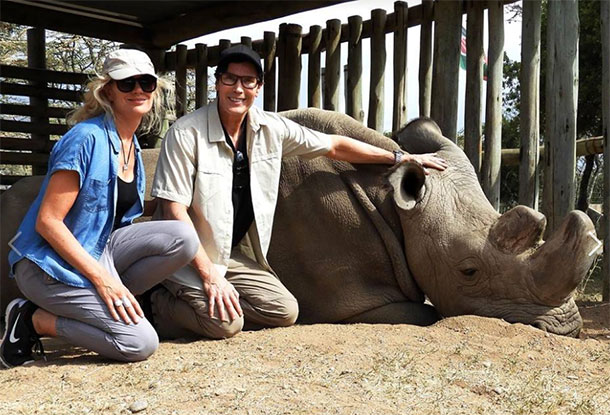Science Note: A Moonshot To Save Rhinos
Air Date: Week of July 27, 2018

Animal conservation artists Gillian and Marc Schattner pose with Sudan, the last male Northern White Rhino at the Ol Pejeta conservancy in Kenya. (Photo: Gillieandmartcart, Wikimedia Commons, CC BY-SA 4.0)
The last male Northern White Rhino recently died, leaving the species on the verge of extinction. But researchers have decided to try and preserve the species by injecting preserved sperm of the Northern White Rhino into the eggs of a close subspecies: the Southern White Rhino. Living on Earth’s Don Lyman reports.
Transcript
BASCOMB: Up next – Using genetics to keep track of the highly endangered rhino, but first, this note on emerging science from Don Lyman.
LYMAN: The northern white rhinoceros is teetering on the verge of extinction. The last male died in March, and only two females remain, both in captivity in Kenya.
But there are 20,000 southern white rhinos, a closely related subspecies of the northern white rhino. And for the first time, scientists have injected preserved sperm from a northern white rhino into the eggs of female southern white rhinos – to create rhinoceros embryos in a lab.
Researchers from the Safari Park Dvůr Králové in the Czech Republic incubated embryos until the cells began to differentiate, which is the stage at which they could be implanted into a surrogate mother rhino. The researchers hope to eventually implant similar embryos into female southern white rhinos.
The researchers say even though any baby rhinos born using this technique would be a cross between northern and southern subspecies, it would be a way to preserve northern white rhino genes. Those genes could at some point allow scientists to recreate pure northern white rhinos through selective breeding. It’s an expensive process, and critics say that money could be better spent on conservation for endangered rhinos left in the wild.
Selective breeding for the northern white rhino would take several generations of rhinos and many decades.
However, the scientists are also planning to harvest eggs from the two remaining female northern white rhinos and fertilize those eggs with preserved northern white rhino sperm, a process which could produce a pure bred northern white rhino calf within the next three years.
That’s this week’s note on emerging science. I’m Don Lyman.
Links
Living on Earth wants to hear from you!
Living on Earth
62 Calef Highway, Suite 212
Lee, NH 03861
Telephone: 617-287-4121
E-mail: comments@loe.org
Newsletter [Click here]
Donate to Living on Earth!
Living on Earth is an independent media program and relies entirely on contributions from listeners and institutions supporting public service. Please donate now to preserve an independent environmental voice.
NewsletterLiving on Earth offers a weekly delivery of the show's rundown to your mailbox. Sign up for our newsletter today!
 Sailors For The Sea: Be the change you want to sea.
Sailors For The Sea: Be the change you want to sea.
 The Grantham Foundation for the Protection of the Environment: Committed to protecting and improving the health of the global environment.
The Grantham Foundation for the Protection of the Environment: Committed to protecting and improving the health of the global environment.
 Contribute to Living on Earth and receive, as our gift to you, an archival print of one of Mark Seth Lender's extraordinary wildlife photographs. Follow the link to see Mark's current collection of photographs.
Contribute to Living on Earth and receive, as our gift to you, an archival print of one of Mark Seth Lender's extraordinary wildlife photographs. Follow the link to see Mark's current collection of photographs.
 Buy a signed copy of Mark Seth Lender's book Smeagull the Seagull & support Living on Earth
Buy a signed copy of Mark Seth Lender's book Smeagull the Seagull & support Living on Earth

